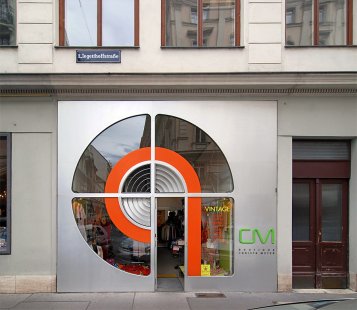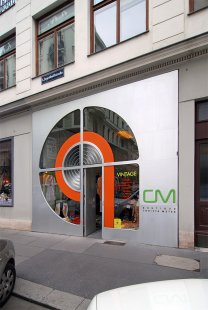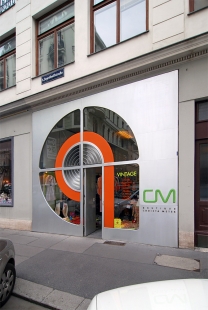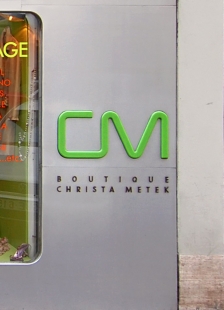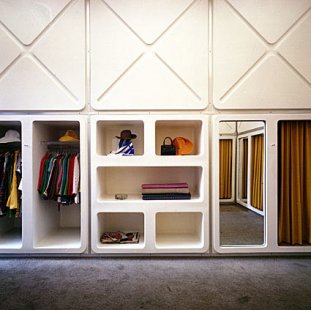
Boutique Christa Metek

Sign and Signal in Contemporary Architecture
On one of the streets near the center of Vienna, an unusual commercial portal has appeared: an orange colored strip rises along a flat plate of anodized aluminum, turning into the shape of a glowing question mark. A strip of glass reflecting the facades of the opposite buildings and the happenings on the street follows it. A signal. A pedestrian unconsciously crosses the roadway and approaches the unusual phenomenon… The new realization by Vienna architect Hans Hollein for the company Metek undoubtedly belongs to the other expressions of profound changes in contemporary architecture, affecting the very essence of this creation: architectural space. This space is no longer merely a shell for operational lines, something overlooked, as architectural theory and creation appeared in the previous decades. After a period dominated by construction, space is reclaiming its position as the central problem in architectural creation.
We observed a pedestrian approaching the unusual portal marked with large yellow letters CM. We noted that the urban space surrounding the shop – that street space from the last century – suddenly transforms into a kind of force field. The commercial portal becomes a signal within it, a source of energy, an attractive force radiating in all directions in some sort of spherical wavefronts. The pedestrian's field of vision, until now quite monotonous, is suddenly under the power of a planar entity, a planar form that is more painterly than relief-like, under the power of an irresistible phenomenon. As we approach, we realize that this signal-attractor is actually an entry point. The orange color of the undulating strip is bordered by glass, enclosing doors within itself. The glass strip, accompanying the orange color, allows us to catch a glimpse of the interior. Our eyes catch sight of displayed model clothing, several fashion accessories, and part of an interesting interior. Yet that glass strip suggests with its form that its function is not to allow a view inside, but rather to evoke a desire to look inside. Once the pedestrian begins to look, they realize that they are somewhat "peeking" through an opening that "defies" their gaze, which does not permit, unless the viewer presses their nose against the glass, to form a satisfying impression of the interior. And the doors, they are completely opaque! Only a small circular window by the handle allows us to detect the hand of a departing person who could collide with us from the other side. Thus, the entire portal of the store is a signal that compels us to change our path. It awakens our interest. And when we get closer, we discover its symbolic nature, the fact that it refers to a space that signals, but does not reveal. And here we almost come to some sort of impact, to disappointment. If we are very close to the portal, we know little more about the store than we did before. And what initially captivated us has not revealed its secret; on the contrary: it has directed us further. Thus, we must enter...
The interior of the store is a space of measured proportions, quite high and illuminated by the diffuse light of a shining ceiling. By its nature, it is static, it slows and eventually completely halts our movement. Our eyes unconsciously glide over the walls. The white walls, processed with deep relief, are made of polyester and break into protrusions that serve as shelves. Opposite us, as we enter, there are several mirrors and entrances to small side rooms and fitting rooms. Their curtains shine with fluorescent yellow. In the mirror, we see the entrance area of the shop: behind the question mark of the portal, the street lives, in front of it, around the doors, is the display area, seamlessly merging with the entire space of the store. A small table – definitely not a counter – stands in the middle. Yet even that does not prevent the visitor from moving. The space invites acquaintance with everything the shop contains and conditions the interaction with the seller: this interaction can occur only in the form of a dialogue between two equal partners. The relationship of the seller and buyer to the goods is determined equally by the space. For both, the goods are within the same reach, both move freely throughout the entire space. Thus, there is a deliberate merging of functions in one space and not a strictly separated zone for the seller and the buyer. And this characteristic is supplemented by another: in the near future, there are plans for the expansion of the internal spaces, although it has yet to be determined how. All this is meant to emerge from the specific requirements as the operation of the shop soon reveals. And therefore, this space, perfectly defined and seemingly definitive, is merely one of the possibilities. The modular grid and composability, as well as the mutual interchangeability of wall segments allow it to change into other elements from its set of possibilities, giving it a sort of new dimension, the dimension of possible – albeit discontinuous – development over time that would meet the ever-changing demands of human events and activities that will take place in this space. Thus, a revived characteristic of contemporary architectural creation asserts itself: the idea of growth, the evolution of space.
Colors, light, space as a force field, a space that also attacks our will and feelings. And the question mark of the portal, which hints at the store, we carry away as a brand even on the packaging of the purchased goods. It is a hieroglyph, a sign-concept. And all components of the work organically merge into a new, higher meaningful unity. Architecture, in this conception, rigorously and consciously becomes a message, a proclamation, a communiqué (message), information coded into space. Its aim and purpose is the human environment. And it is not just a dead, empty space that “does not prevent” mannequins from moving. It becomes an external part of our existence, bearing HUMAN MEANINGS.
On one of the streets near the center of Vienna, an unusual commercial portal has appeared: an orange colored strip rises along a flat plate of anodized aluminum, turning into the shape of a glowing question mark. A strip of glass reflecting the facades of the opposite buildings and the happenings on the street follows it. A signal. A pedestrian unconsciously crosses the roadway and approaches the unusual phenomenon… The new realization by Vienna architect Hans Hollein for the company Metek undoubtedly belongs to the other expressions of profound changes in contemporary architecture, affecting the very essence of this creation: architectural space. This space is no longer merely a shell for operational lines, something overlooked, as architectural theory and creation appeared in the previous decades. After a period dominated by construction, space is reclaiming its position as the central problem in architectural creation.
We observed a pedestrian approaching the unusual portal marked with large yellow letters CM. We noted that the urban space surrounding the shop – that street space from the last century – suddenly transforms into a kind of force field. The commercial portal becomes a signal within it, a source of energy, an attractive force radiating in all directions in some sort of spherical wavefronts. The pedestrian's field of vision, until now quite monotonous, is suddenly under the power of a planar entity, a planar form that is more painterly than relief-like, under the power of an irresistible phenomenon. As we approach, we realize that this signal-attractor is actually an entry point. The orange color of the undulating strip is bordered by glass, enclosing doors within itself. The glass strip, accompanying the orange color, allows us to catch a glimpse of the interior. Our eyes catch sight of displayed model clothing, several fashion accessories, and part of an interesting interior. Yet that glass strip suggests with its form that its function is not to allow a view inside, but rather to evoke a desire to look inside. Once the pedestrian begins to look, they realize that they are somewhat "peeking" through an opening that "defies" their gaze, which does not permit, unless the viewer presses their nose against the glass, to form a satisfying impression of the interior. And the doors, they are completely opaque! Only a small circular window by the handle allows us to detect the hand of a departing person who could collide with us from the other side. Thus, the entire portal of the store is a signal that compels us to change our path. It awakens our interest. And when we get closer, we discover its symbolic nature, the fact that it refers to a space that signals, but does not reveal. And here we almost come to some sort of impact, to disappointment. If we are very close to the portal, we know little more about the store than we did before. And what initially captivated us has not revealed its secret; on the contrary: it has directed us further. Thus, we must enter...
The interior of the store is a space of measured proportions, quite high and illuminated by the diffuse light of a shining ceiling. By its nature, it is static, it slows and eventually completely halts our movement. Our eyes unconsciously glide over the walls. The white walls, processed with deep relief, are made of polyester and break into protrusions that serve as shelves. Opposite us, as we enter, there are several mirrors and entrances to small side rooms and fitting rooms. Their curtains shine with fluorescent yellow. In the mirror, we see the entrance area of the shop: behind the question mark of the portal, the street lives, in front of it, around the doors, is the display area, seamlessly merging with the entire space of the store. A small table – definitely not a counter – stands in the middle. Yet even that does not prevent the visitor from moving. The space invites acquaintance with everything the shop contains and conditions the interaction with the seller: this interaction can occur only in the form of a dialogue between two equal partners. The relationship of the seller and buyer to the goods is determined equally by the space. For both, the goods are within the same reach, both move freely throughout the entire space. Thus, there is a deliberate merging of functions in one space and not a strictly separated zone for the seller and the buyer. And this characteristic is supplemented by another: in the near future, there are plans for the expansion of the internal spaces, although it has yet to be determined how. All this is meant to emerge from the specific requirements as the operation of the shop soon reveals. And therefore, this space, perfectly defined and seemingly definitive, is merely one of the possibilities. The modular grid and composability, as well as the mutual interchangeability of wall segments allow it to change into other elements from its set of possibilities, giving it a sort of new dimension, the dimension of possible – albeit discontinuous – development over time that would meet the ever-changing demands of human events and activities that will take place in this space. Thus, a revived characteristic of contemporary architectural creation asserts itself: the idea of growth, the evolution of space.
Colors, light, space as a force field, a space that also attacks our will and feelings. And the question mark of the portal, which hints at the store, we carry away as a brand even on the packaging of the purchased goods. It is a hieroglyph, a sign-concept. And all components of the work organically merge into a new, higher meaningful unity. Architecture, in this conception, rigorously and consciously becomes a message, a proclamation, a communiqué (message), information coded into space. Its aim and purpose is the human environment. And it is not just a dead, empty space that “does not prevent” mannequins from moving. It becomes an external part of our existence, bearing HUMAN MEANINGS.
The English translation is powered by AI tool. Switch to Czech to view the original text source.
0 comments
add comment


